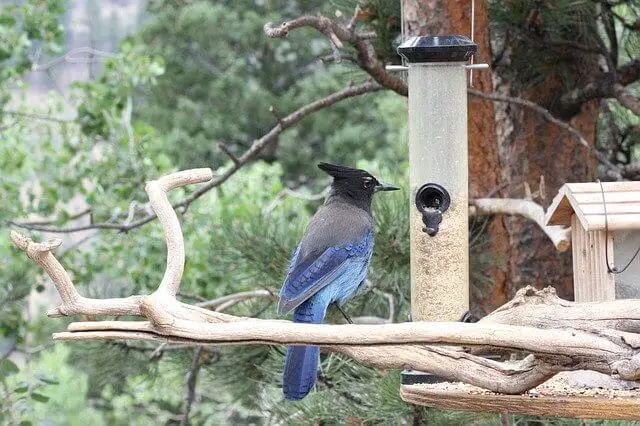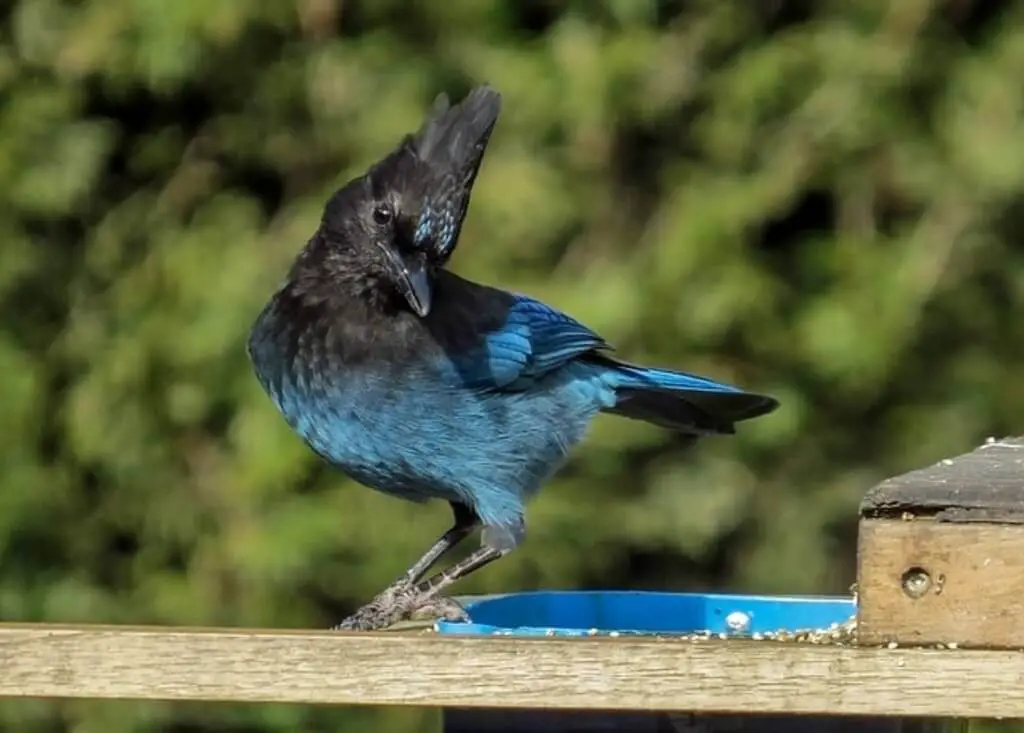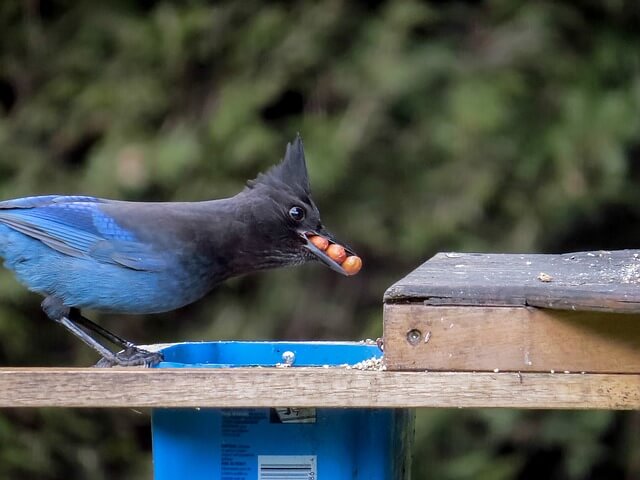
Attracting Steller’s Jay is not as hard as you may think. They will come to your yard if they feel it is safe and has plenty of food for them to eat. It can be a bit difficult, but there are ways that you can attract these beautiful birds into your backyard with ease.
In this article we will be discussing the most effective methods for attracting Steller Jay’s into your yard, along with what kind of feeder should work best for them.
Table of Contents
Identification
The Steller’s Jay is a medium-sized bird measuring 30–34 cm (11.8–13.4 in) long and weighs about 100–142 g (3.5–5.0 oz) that is found in the west coast of North America.
It is easy to identify, they look very similar to blue jays but are slightly larger, with a charcoal black hood and crest with a dark blue body.
Habitat
The Stellar Jay lives in the woodlands of North America, but have been found as far south as Mexico and Costa Rica. These birds are found throughout Canada and the United States including Maine, New York, Wisconsin, Michigan, and Montana.
They live in areas with dense underbrush or forest cover near open spaces for feeding purposes. Their preferred habitat includes forested areas where they can find food like insects and seeds as well as trees to nest on.
What do Steller’s Jay eat?
Steller Jay’s have an omnivorous diet and live mostly on acorns, seeds, pine nuts, bugs such as beetles, crickets and maggots, as well as insects like earthworms, wax worms, wasps, ants, crickets, termites, lacewings, and roaches which they store in tree holes or other food caches for later use during winter months when food sources are scarce.
However, they also eat berries such as raspberries, strawberries and blueberries from time to time.
Attracting the Steller’s Jay with Feeders
The best way to attract Steller Jays is by feeding them. A feeder for these birds should be easy to fill and hold a variety of food. The most popular feeders for Steller jays are these suet and tray style platform feeders. You can pick them up on Amazon.
Suet provides seeds, fruit, nuts, or insects that this bird likes while the tray will provide sunflower seeds as well as other types of seeds such as millet. To make your own suet just take peanut butter and apples and make balls, or you can purchase the insect suet on Amazon.
If you decide to use a tray style platform feeder instead you can still use suet, or you can use cut fruit such as apples, cherries, grapes, black-oil sunflower seed, shelled peanuts or millet.
Check out my article on top feeder picks: 15 Best Bird Feeders For Jays.
Choosing the best place for your bird feeder can be difficult. The location should have a number of things to consider, including: shade, protection from predators, and good visibility. You want to avoid placing it in direct sunlight because it will spoil the food, and it will attract bugs instead of birds.
It also needs to be away from places where predators could reach them or if they are located on the ground then they need to be hung up in a tree where it is visible by the birds, so they know where their food source is located.
Jays will be able to see the feeders if they are hung up on a nearby tree or if they are placed in an open area that is visible from any angle. Place the feeder where it can be supported so that it does not swing easily.
Foods that Attract Steller Jay’s
Some of the most popular food sources for Steller Jays include:
- Suet
- Dogwood
- Black-oil and striped sunflower seeds
- Cherries
- Fruits (apples, melons, bananas, grapes, cherries, most berries, dried fruit etc.)
- Elderberries
- Acorns
- Shelled Peanuts
- Peanut Butter

Attract the Steller’s Jay with a Birdbath
Looking for a way to attract more jays? Put out a birdbath! Jays love the water and will come close to your house in order to bathe. Here are some tips for getting these beautiful birds on your property:
– First and foremost, be sure the birdbath is clean. Make it inviting by adding fresh water every day and scrubbing it down periodically with a diluted bleach solution (1 part bleach to 9 parts water).
– Make sure that the birdbath is located in an area where there are trees or shrubs for shade and cover. Jays are attracted to areas with plenty of food sources as well as water.
– Offer a variety of foods, including seed mix, peanuts, raisins and apples at the birdbath; jays also enjoy bread crumbs and suet.
– Put some water-loving plants around the birdbath for aesthetic purposes and also because they may provide additional food sources.
– Make sure there is plenty of room around the birdbath.
- If you would like to see more birds in your garden, then I would really recommend investing in a birdbath. This is the one I purchased on Amazon, click here.
Give them Shelter
Steller Jays have a very specific nesting needs, and will only nest on platforms that are located on an open perch or limb at least 25 feet off of the ground.
This is because they rely heavily on sight for hunting insects and other prey items as well as predators, which become more difficult to find when their nests are too close to the forest floor.
An open-nesting platform with a perch provides them with this perfect location while also providing the bird with a home. This is open-nesting platform I’m using, you can find it on Amazon.
Attract them with Trees
Steller Jays are found mainly in forests with oak trees or on higher elevation pine tree plantations.
They nest in tree cavities high up on coniferous trees like Ponderosa Pine, Douglas Fir, Grand Fir, Western Red Cedar, Oak, Beech, or Pinyon Pine.
Attract them with Flowers
Steller Jays can be attracted to your yard with the use of flowers, or by planting flowers in a specific manner.
Plant nectar-producing plants such as cardinal flowers, sunflowers, goldenrod, zinnias and bee balm near your feeders for jays to enjoy when they come down from their perches.




